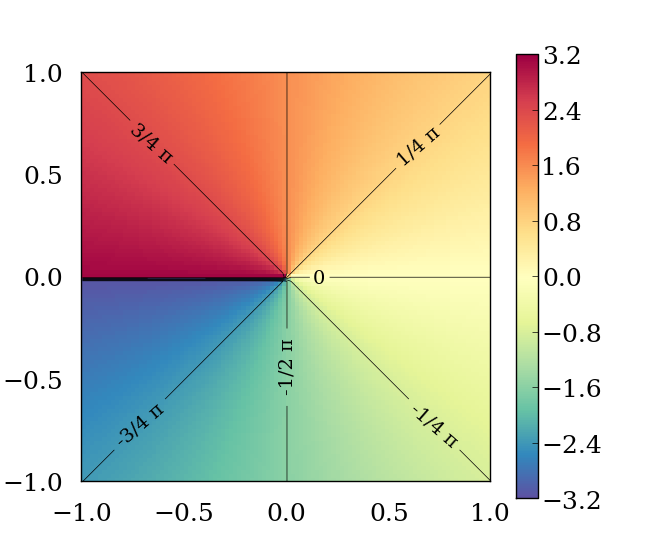Atan2
Defined in header <cmath>.
Description
Computes the arc tangent of y / x using the signs of arguments to determine the correct quadrant.
The library provides overloads of std::atan2 for all cv-unqualified floating-point types as the type of the parameters y and x (since C++23).
Additional Overloads are provided for all other combinations of arithmetic types (since C++11).
Declarations
- C++23
- C++11
// 1)
/* floating-point-type */ atan2( /* floating-point-type */ y,
/* floating-point-type */ x );
// 2)
float atan2f( float y, float x );
// 3)
long double atan2l( long double y, long double x );
// 4)
template< class Arithmetic1, class Arithmetic2 >
/* common-floating-point-type */ atan2( Arithmetic1 y, Arithmetic2 x );
// 1)
float atan2 ( float y, float x );
// 2)
double atan2 ( double y, double x );
// 3)
long double atan2 ( long double y, long double x );
// 4)
float atan2f( float y, float x );
// 5)
long double atan2l( long double y, long double x );
// 6)
template< class Arithmetic1, class Arithmetic2 >
/* common-floating-point-type */ atan2( Arithmetic1 y, Arithmetic2 x );
Parameters
y, x - floating-point or integer values
Return value
If no errors occur, the arc tangent of y / x (arctan(x/y)) in the range [-π, +π] radians, is returned.

If a domain error occurs, an implementation-defined value is returned (NaN where supported).
If a range error occurs due to underflow, the correct result (after rounding) is returned.
Error handling
Errors are reported as specified in math_errhandling.
Domain error may occur if x and y are both zero.
If the implementation supports IEEE floating-point arithmetic (IEC 60559),
- If
xandyare both zero, domain error does not occur - If
xandyare both zero, range error does not occur either - If
yis zero, pole error does not occur - If
yis±0andxis negative or-0,±πis returned - If
yis±0andxis positive or+0,±0is returned - If
yis±∞andxis finite,±π/2is returned - If
yis±∞andxis-∞,±3π/4is returned - If
yis±∞andxis+∞,±π/4is returned - If
xis±0andyis negative,-π/2is returned - If
xis±0andyis positive,+π/2is returned - If
xis-∞andyis finite and positive,+πis returned - If
xis-∞andyis finite and negative,-πis returned - If
xis+∞andyis finite and positive,+0is returned - If
xis+∞andyis finite and negative,-0is returned - If either
xis NaN oryis NaN, NaN is returned
Notes
std::atan2(y, x) is equivalent to
std::arg(std::complex<std::common_type_t<decltype(x), decltype(y)>>(x, y))
POSIX
specifies that in case of underflow, y / x is the value returned, and if that is not supported, an implementation-defined value no
greater than DBL_MIN, FLT_MIN, and LDBL_MIN is returned.
The additional overloads are not required to be provided exactly as Additional Overloads.
They only need to be sufficient to ensure that for their first argument num1 and second argument num2:
If num1 or num2 has type long double, then
std::atan2(num1, num2) has the same effect as
std::atan2(static_cast<long double>(num1), static_cast<long double>(num2)).
Otherwise, if num1 and/or num2 has type double or an integer type, then
std::atan2(num1, num2) has the same effect as
std::atan2(static_cast<double>(num1), static_cast<double>(num2)).
num1 or num2 has type float, then std::atan2(num1, num2) has the same effect as
std::atan2(static_cast<float>(num1), static_cast<float>(num2)). (until C++23)
If num1 and num2 have arithmetic types, then
std::atan2(num1, num2) has the same effect as
std::atan2(static_cast</* common-floating-point-type */>(num1), static_cast</* common-floating-point-type */>(num2)).
where /* common-floating-point-type */ is the floating-point type with the greatest floating-point conversion rank and
greatest floating-point conversion subrank between the types of num1 and num2,
arguments of integer type are considered to have the same floating-point conversion rank as double.
If no such floating-point type with the greatest rank and subrank exists, then overload resolution does not result in a usable candidate from the overloads provided.
Examples
#include <cmath>
#include <iostream>
void print_coordinates(int x, int y)
{
std::cout
<< std::showpos
<< "(x:" << x << ", y:"
<< y << ") cartesian is "
<< "(r:" << std::hypot(x, y)
<< ", phi:" << std::atan2(y, x)
<< ") polar\n";
}
int main()
{
// normal usage: the signs of the two arguments determine the quadrant
print_coordinates(+1, +1);
// atan2( 1, 1) = +pi/4, Quad I
print_coordinates(-1, +1);
// atan2( 1, -1) = +3pi/4, Quad II
print_coordinates(-1, -1);
// atan2(-1, -1) = -3pi/4, Quad III
print_coordinates(+1, -1);
// atan2(-1, 1) = -pi/4, Quad IV
// special values
std::cout
<< std::noshowpos
<< "atan2(0, 0) = "
<< atan2(0, 0) << '\n'
<< "atan2(0,-0) = "
<< atan2(0, -0.0) << '\n'
<< "atan2(7, 0) = "
<< atan2(7, 0) << '\n'
<< "atan2(7,-0) = "
<< atan2(7, -0.0) << '\n';
}
(x:+1, y:+1) cartesian is (r:1.41421, phi:0.785398) polar
(x:-1, y:+1) cartesian is (r:1.41421, phi:2.35619) polar
(x:-1, y:-1) cartesian is (r:1.41421, phi:-2.35619) polar
(x:+1, y:-1) cartesian is (r:1.41421, phi:-0.785398) polar
atan2(0, 0) = 0
atan2(0,-0) = 3.14159
atan2(7, 0) = 1.5708
atan2(7,-0) = 1.5708